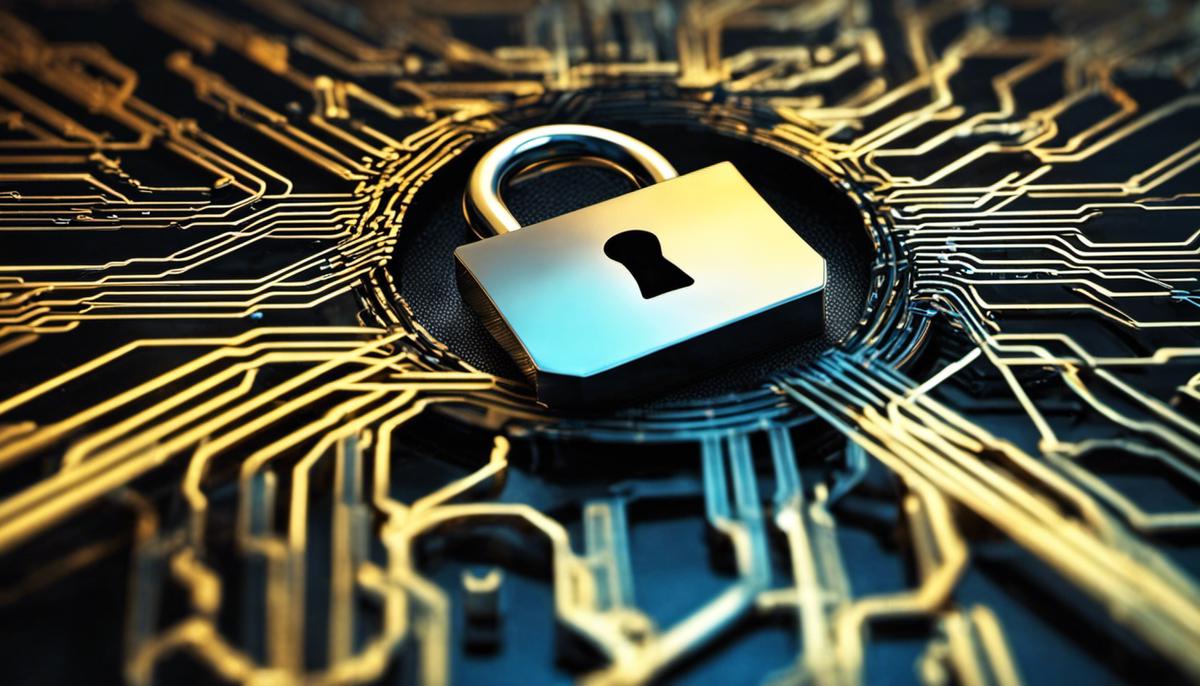This guide aims to provide an in-depth exploration of cutting-edge cybersecurity solutions, the current threat landscape, the repercussions of these threats on businesses, how to evaluate and integrate effective cybersecurity solutions, and a glimpse into the future of this critical field.
Understanding the Cybersecurity Threat Landscape
Unpacking the Formidable Threats in Today’s Cybersecurity Landscape
In the ceaselessly evolving realm of technology, challenges abound. One such challenge is the cybersecurity landscape, which has never been as critical or complex as it is today. With businesses and individuals alike becoming ever more dependent on advanced technology for day-to-day operations, the stakes have exponentially increased. Today, we’ll dive into the major threats that lurk in this highly digitalized world.
Phishing Attacks
Topping the list of cybersecurity threats is the infamous phishing phenomenon. Criminals employ clever social engineering tactics, tricking unsuspecting individuals into revealing sensitive information like passwords and credit card numbers. They mask as trustworthy institutions, leveraging our reliance on technology against us. Although this type of threat has been around for a while, the sophistication of these attacks continues to evolve, making them increasingly difficult to detect.
Ransomware is an enemy that doesn’t shy away from the limelight. From the global WannaCry attack that crippled hospitals and businesses alike to the recent Colonial Pipeline crisis that exposed vulnerabilities in critical infrastructure, it’s clear that ransomware has raised the stakes. Attackers lock users out of their own devices, demanding payments in exchange for access, leading to loss of data, money, and, often, peace of mind.
Cryptojacking
Next on the horizon is cryptojacking. As cryptocurrencies like Bitcoin surge in value, hackers are exploiting innocent users’ computer resources to mine these digital currencies. This form of attack might seem less destructive than others, as it primarily drains computational power and inflates energy bills. However, the damage to device performance and latency issues are serious issues for technology-dependent businesses, not to mention the ethical and legal implications.
Cloud Vulnerabilities
Cloud technology has emerged as the hero of remote work during the pandemic. However, this knight in shining armor isn’t invincible. Cloud cybersecurity threats are escalating as more organizations entrust their sensitive data to third-party servers. Encryption blind spots, poor access management, and inadequate data deletion practices are some of the cloud-specific vulnerabilities for exploitation.
IoT and Smart Device Hacking
The burgeoning Internet of Things (IoT) and smart devices have unlocked a Pandora’s box of cybersecurity threats. Abundant connectivity comes with abundant risk. Many smart devices are deployed with weak default configurations and irregular software updates, presenting gaping opportunities for hackers to breach our data and privacy.
Deepfakes
Lastly, but certainly not least, there’s the pernicious threat of deepfakes. Combining machine learning and AI to create convincing fake audio and video content, deepfakes pose a unique and multilayered cybersecurity threat. Their potential for spreading disinformation or conducting fraudulent activities is staggeringly high.
From phishing to deepfakes, the threats arrayed against us in the cybersecurity landscape are formidable. As technology continues to surge ahead, it’s vital to advance our defenses in step, understanding each threat and taking proactive measures to protect ourselves. It’s a dynamic and often challenging terrain but one that cannot be ignored in this digital age.

Revolutionary Cybersecurity Solutions
Forward-Thinking Strategies and Technologies to Counter Cyber Threats
In the ever-evolving world of cyber security, the status quo is quickly outdated. With malicious actors always looking to exploit new vulnerabilities or create innovative tactics, those tasked with securing networks must continuously stay ahead. Let’s explore some of the unique technologies being utilized today to fend off these cyber threats.
One emerging technology aimed at combatting the insidious world of cyber threats is Machine Learning and Artificial Intelligence (AI). It sounds futuristic, but it’s happening right here, right now. Machine Learning algorithms are not just reactive but predictive. They can alert us to anomalous behavior, possibly indicating an intrusion attempt, while AI tools reflect on historical data to identify patterns and anticipate future attacks. These technologies add a pro-active element to cyber defense strategy, not simply responding to a threat but potentially detecting and neutralizing it before it unfolds.
The second addition to the cyber security arsenal is blockchain technology. Yes, that blockchain is known for monumentally transforming the financial sector through cryptocurrencies. So, how does it help in the digital battle against cyber threats? Blockchain operates on a highly decentralized digital ledger system, providing an unparalleled level of security. Data in a blockchain is encrypted and distributed across many nodes, making it near-impossible for hackers to alter or delete.
The third new frontier to consider in the fight against cyber threats is Quantum Cryptography. Admittedly, it’s still in its nascent stages, but the theory is rock-solid. Essentially, quantum cryptography uses the principles of quantum mechanics to encrypt data. Any attempt to ‘eavesdrop’ or interfere with the data causes it to alter or self-destruct. This technology will help create a practically unhackable communication channel, significantly reducing the risk of data breaches.
Lastly, we must recognize the role of Cyber Threat Intelligence (CTI). CTI involves gathering and analyzing information about emerging trends in cyber threats from various sources and disseminating actionable intelligence to organizations. This discipline continues to evolve, aided by new technologies and platforms that streamline the process of collecting, analyzing, and sharing real-time cyber threat data.
It’s a novel approach to an age-old problem. Cybersecurity isn’t about eliminating the risk; that’s simply not feasible. Instead, the focus is shifting. Forward-thinking, innovative technologies that anticipate threats and diffuse them before they wreak havoc are the new vanguard of the digital battlefield. Cybercrime will never cease to exist, but equipping ourselves with the latest technology will ensure we’re always one step ahead in this ongoing war.

Impact of Cybersecurity on Businesses
A robust cybersecurity approach does more than safeguard an organization from outside threats. It serves as the cornerstone for sustainable business operations by ensuring the integrity, confidentiality, and availability of crucial data and systems. Embracing a comprehensive cybersecurity strategy directly influences productivity, customer trust, and competitive edges and is no longer a mere option but an absolute necessity in the tech-heavy business landscape.
Data accuracy and integrity are at the heart of efficient business operations, driving critical decision-making processes. By applying advanced cybersecurity strategies like behavioral analytics, businesses can proactively spot abnormal behaviors or patterns within their system. Going beyond incident detection, this approach facilitates proactive threat hunting, thereby ensuring that data remains accurate and reliable. It also saves substantial time and financial resources by preventing breaches before they occur.
Further, cybersecurity intricacies extend into the realm of business continuity planning. Data breaches or cyber attacks can result in significant downtime, with operations grinding to a halt. Exceptional cybersecurity measures minimize this risk by ensuring business continuity even in the face of attacks. Advanced technologies, like Disaster Recovery as a Service (DRaaS), can automate and streamline recovery processes, reducing downtime and, subsequently, operational interruption.
Also, there’s a growing emphasis on privacy regulations such as GDPR and CCPA, which impose stringent data protection requirements on businesses. A sound cybersecurity plan navigates the maze of regulatory requirements, ensuring businesses are compliant and avoiding hefty fines that could cripple operations or damage reputations.
In an era where trust is a defining currency, cybersecurity directly influences a company’s reputation among customers. Clients are more likely to commit to brands that prioritize data privacy and security. Strong cybersecurity posture equates to trustworthy business practices, proving pivotal in both customer acquisition and retention, hence directly promoting sustainability.
Finally, it’s worth noting that cybersecurity effectiveness influences the competitive landscape. For businesses operating in tech-dominant fields, it sends a powerful message about a company’s culture and operational efficiency and sets them ahead in the fiercely competitive market.
Cybersecurity is an essential element that shapes a myriad of business operational factors and, in turn, the sustainability of an enterprise. As the cyber threat landscape evolves, so too must the approaches to secure a safe digital space. Moving forward, the focus must be on implementing advanced and proactive strategies that not only protect businesses today but also prepare them for the unknown threats of tomorrow.

Cybersecurity Solutions Evaluation and Integration
Moving forward, it is necessary to understand the factors that should be taken into account when considering cybersecurity solutions. No matter how advanced, every security solution should be evaluated against key criteria to ensure it meets the business’s organizational and strategic needs.
First, make sure the solution supports seamless integration with your existing technology stack. The last thing you want is a complicated integration process that may disrupt ongoing business operations. The security solution should easily merge with your existing infrastructure and support the operating systems and applications your business already uses.
Next, what is the scalability of the solution? As businesses evolve and grow, their cybersecurity requirements will unavoidably change. You should strive for a scalable cybersecurity solution that adapts to technological advances and evolving business needs. It should support the future expansion of your business – serving not only current needs but anticipated future requirements, too.
Take a closer look at the supplier’s reputation in the market. An esteemed reputation implies a sound track record, reliable service, and a higher likelihood of consistent support throughout a tech lifecycle. Research independent reviews to get a bigger picture of long-term performance and customer satisfaction.
Delving into the solution’s levels of security and functionalities is critical. Opt for a solution that provides layered security and supports a gamut of advanced cybersecurity approaches like Micro-segmentation, Zero Trust Architecture, and Threat Hunting. This ensures more resilient protection against complex, mutating cybersecurity threats.
Consider the ease of use and management of the cybersecurity solution. Overly complicated systems not only confuse users but might also lead to slow adoption and mistaken errors that might leave the business vulnerable.
Price will always factor into any business decision. The optimal cybersecurity solution should be cost-effective, not just in terms of acquisition but also in operation, maintenance, and upgrading.
Compliance is a must-have. Any cybersecurity tool you choose has to adhere to the compliance regulations your business is subject to, be it HIPAA, CCPA, GDPR, or others. Non-compliance can lead to severe fines and damage your business’s reputation.
Lastly, consider the solution’s ability to provide real-time analytics and reports. Real-time visibility into network activity can help identify patterns, and unusual or suspicious behavior and aid in the timely detection and response to threats.
In conclusion, being on the cutting edge of cybersecurity development requires a well-laid strategy, and the final choice of a cybersecurity solution should align with business needs, growth plans, regulatory requirements, and the evolving technological landscape. Applying these evaluation criteria when choosing a solution can help businesses stay one step ahead in the ongoing war against cybercrime.
Future of Cybersecurity
Title: Future-Scape of Cybersecurity Solution Development and Implementation
As the world of cybersecurity vaults into the future, emerging technologies exhibit promising potential while the sophistication of cyber threats keeps climbing the ladder. The solutions that will make a difference are the ones that gear towards the enhancement of detection technology, compliance adaptability, and predictive foresight.
Hyper-automation paves the way for adaptive security. By integrating multiple ML models, the adaptive security infrastructure will achieve intuitive responses to security threats. It quantifies the potential risks and has the ability to run improvisations based on initial calculations, thus establishing swiftly responding systems.
The future asks for Zero Trust Architecture. Demolishing the “Trust and Verify” concept, the Zero Trust Architecture takes the “Never Trust, Always Verify” approach. This technology ensures access control by subjecting every access request to strict identity verification. This allows real-time threat blocking and reinforces the security at microlevels.
Data Privacy by Design and by Default is the new favored mantra. As mentioned in Article 25 of the GDPR, organizations are increasingly integrating security features in the initial stages of product design as opposed to it being a supplementary feature. Such an integrated model ensures greater robustness in protecting sensitive data.
Cybersecurity Mesh architecting is a novel approach to ensure a more focused security system. Instead of a centralized security system, cybersecurity mesh provides a modular security approach by decentralizing policy enforcement. Further enhancements are being made to this technology to ensure an encapsulated protection system for each module.
Next-Gen Endpoint Security, replacing the traditional antivirus software, is a solution that understands and scrutinizes patterns to be able to ward off threats more effectively. This proactive solution developed to secure endpoints will help in early detection and faster mitigations of threats.
Cloud-First Cybersecurity Framework a solution rising to the top, considering the increase in cloud-based applications and systems. This framework prioritizes the security of cloud-based systems and extends to secure remote and mobile users, giving protection outside traditional network boundaries.
Integrating Cybersecurity into DevOps or the emergence of DevSecOps – the current forward-thinking technology, is an efficient way to imbue security deeply within the code. DevSecOps, an avant-garde solution, ensures early and continuous security checks throughout the development lifecycle, leading to fewer security issues post-deployment.
In conclusion, the fulfillment of a secure future in the digital space lies in the continuance of development and implementation. Being lucid with the changing trends in the cybersecurity world, strong analytical abilities in tech enthusiasts must dictate the dynamic shift toward flexible and integrative solutions. The horizon of cybersecurity holds a surpassing potential in securing the future, demanding vigilance and relentless exploration.

As we move ahead in the digital era, the role of cybersecurity is set to grow even more crucial. While groundbreaking advancements like machine learning, AI, and blockchain are shaping a new horizon of cybersecurity, businesses must also stay vigilant and prepared for the emerging threats. Evaluating and deploying effective cybersecurity solutions is, therefore, not just a choice but a requisite in today’s landscape. Beyond this, the ever-evolving nature of this field calls for relentless dedication to innovation, an understanding of changing regulations, and adherence to ethical considerations. It is, hence, apparent that the journey of becoming an expert in cybersecurity solutions is not a destination but a continuous process of learning, adaptation, and forward-thinking.

